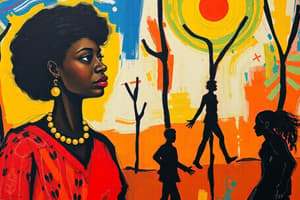Podcast
Questions and Answers
Who was Ida B. Wells?
Who was Ida B. Wells?
The daughter of African American slaves who published 'Southern Horrors' in 1892.
What is 'Southern Horrors' about?
What is 'Southern Horrors' about?
It discusses the accusations of black men being lynched under false pretenses of rape.
Who was Pauline Newman?
Who was Pauline Newman?
A labor activist who helped improve working conditions for women in garment factories in New York.
What did Annelise Orleck discuss?
What did Annelise Orleck discuss?
What was the Women's Trade Union League?
What was the Women's Trade Union League?
What was the New York City Shirtwaist Strike?
What was the New York City Shirtwaist Strike?
What was the significance of the Homestead Act of 1862?
What was the significance of the Homestead Act of 1862?
What did the published guide books warn about?
What did the published guide books warn about?
Who was Catherine Beecher?
Who was Catherine Beecher?
What did the Utah Suffrage Bill of 1869 accomplish?
What did the Utah Suffrage Bill of 1869 accomplish?
What was the focus of the Minimum Wage Laws passed in 1912?
What was the focus of the Minimum Wage Laws passed in 1912?
What occurred during the Massachusetts Textile Strike of 1912?
What occurred during the Massachusetts Textile Strike of 1912?
What was the outcome of the murder trial of Mary Phagan in 1913?
What was the outcome of the murder trial of Mary Phagan in 1913?
What did the International Ladies Garment Workers Union achieve?
What did the International Ladies Garment Workers Union achieve?
How did race and socioeconomics impact abortion rates during the Great Depression?
How did race and socioeconomics impact abortion rates during the Great Depression?
What was the significance of the National American Woman Suffrage Association formed in 1890?
What was the significance of the National American Woman Suffrage Association formed in 1890?
What did the 'Work or Fight Law' enacted in 1918 entail?
What did the 'Work or Fight Law' enacted in 1918 entail?
What was the role of women's occupations in 1890?
What was the role of women's occupations in 1890?
Flashcards are hidden until you start studying
Study Notes
Ida B. Wells
- Published "Southern Horrors" in 1892.
- Daughter of African American slaves who fought against the lynching of black men unjustly accused of rape.
Southern Horrors
- Aimed to expose the lynching of black men and the social injustices African Americans faced.
- Discussed the impact of mob violence, propaganda, and economic deprivation on black rights.
- Criticized affluent African Americans for distancing themselves from communal issues.
Pauline Newman
- Active from 1880-1924 in New York, she organized changes in rent and food prices for garment factory workers.
- Advocated for improved working conditions and housing for poor women.
Annelise Orleck
- Explored the challenges faced by immigrant Jews adjusting to life in America.
- Highlighted the shared struggles of garment workers in difficult working conditions.
Women's Trade Union League
- Established in 1903 by middle and upper-class reformers to support women’s organization efforts.
- Struggled to engage male union leaders and focused support towards immigrant Jewish women workers.
New York City Shirtwaist Strike
- Occurred in 1909, involving 20-40,000 workers, primarily teenage girls.
- Workers protested low wages, long hours, and unsafe environments, contributing to broader labor movements.
Westward Migration by Wagon
- Between 1840-1870, approximately 350,000 individuals migrated to California and Oregon.
Completion of the Transcontinental Railroad
- Finished in 1869, it facilitated westward expansion and migration.
Land West of the Mississippi in 1880
- About 20% of the U.S. population lived in this region.
Diary of Kitturah Penton Belknap
- Written in 1839, it detailed her westward journey, including food preparations and supplies.
Travel Time to Oregon or California
- Journeys took six months, involving strenuous daily travel of 16 hours.
Women's Roles While Traveling
- Women managed cooking and laundry, sometimes assuming men’s roles in emergencies.
- Adapted clothing styles for functionality, often wearing bloomers in place of full skirts.
Published Guide Books
- Outlined distinct male and female roles in migration, emphasizing women's resilience in establishing homes.
Kit Belknap
- One of the first women to travel west in 1847 and documented her experiences and struggles.
Homestead Act
- Enacted in 1862, it offered 160 acres of land to settlers who would live on it for five years.
- Of 600,000 families who headed west under the Act, only one-third succeeded in settling.
Catherine Beecher and Female Teachers
- Advocated for female educators in the west in 1850, emphasizing moral guidance over suffrage activism.
- Brought 500 women teachers to frontier schools.
Church of Jesus Christ of Latter-Day Saints (Mormonism)
- Founded in 1830 by Joseph Smith, emerged from a period of religious revivalism.
- Faced opposition in Illinois due to polygamy practices.
Mormonism in Utah
- Established in 1847, the community faced challenges and persecution for its beliefs and practices.
Women's Leadership in Mormonism
- Initially denied to women and African Americans until 1978.
- Domestic roles were idealized; polygamy created divisions among women.
Utah Women's Voting Rights
- Women gained the right to vote in Utah in 1869, creating one of the world’s largest female electorates.
Emmeline Wells
- Supported polygamy for its associated freedoms and shared responsibilities among women.
Polygamy's Legal Status in Utah
- Banned in 1896 to facilitate Utah's admission as a state; voters were required to renounce polygamy.
Chinese Women in the West
- In 1860, many opened businesses targeting single men; approximately 2,000 were forced into labor and prostitution.
Wyoming Suffrage Bill
- Passed in 1869, granted women the right to vote, leading the way for future suffrage movements.
Other State Suffrage Bills
- Various states, including Utah, Colorado, Idaho, and others, implemented suffrage measures from 1869 to 1896.
Women's Suffrage Landscape
- No new suffrage states were created from 1896 to 1910.
Florence Kelley
- Active from 1890-1920, Kelley championed social justice and worked with organizations like Hull House to reform labor laws.
Hull House and Florence Kelley
- Served as a foundation for Kelley's political identity and reform efforts, focusing on women's labor rights.
Minimum Wage Campaign
- Initiated in 1909, aimed to secure better employment standards for women.
Minimum Wage Laws
- Massachusetts passed the first minimum wage law for women in 1912, influencing future legislation including the Fair Labor Standards Act.
Muller v. Oregon
- A landmark 1908 case that led to regulations on working hours, arguing health risks for women working long hours.
Triangle Shirtwaist Company
- Pauline Newman described harsh working conditions leading to the tragic fire that claimed many lives due to locked exit doors.
Margaret Sanger
- Influential in changing perceptions about birth control and helped establish Planned Parenthood; advocated for women’s reproductive rights.
National American Woman Suffrage Association
- Formed in 1890, uniting various suffrage movements under leaders like Elizabeth Cady Stanton and Susan B. Anthony.
Carrie Chapman Catt
- Elected president of the National American Woman Suffrage Association in 1900, Catt organized suffrage campaigns in the West.
Women Workers’ Economic Reality
- Skilled workers earned 20 cents per hour, while unskilled earned 10 cents; average income was insufficient to support families.
New Industrial Cities
- Urbanization led to overcrowded living conditions for impoverished workers, while wealthier classes moved to suburbs.
Settlement House Activism
- Initiated by Hull House in Chicago in 1889, aimed to improve living conditions for immigrants and the urban poor.
Jane Addams
- Co-founder of Hull House, promoted immigrant assimilation and provided education and resources for community improvement.
Dr. S. Weir Mitchell
- Believed women needed prolonged rest post-birth; his views contributed to misconceptions about women's health and capabilities.
Charlotte Perkins Gilman
- Authored "The Yellow Wallpaper" in 1889, critiquing the medical practices restricting women's autonomy.
Abortion Trends in the 1840s
- The rise of commercialization and self-administered procedures reflected limited access and societal stigma associated with terminations.
Great Depression and Abortions
- Economic hardship led women to seek more abortions to avoid bringing children into unsupported circumstances.
Race and Socioeconomics in Abortion
- Abortion rates varied by race and class, with white upper-class women more likely to seek them compared to African American women.
Criminalization of Abortion
- By 1880, most states prohibited abortion, allowing it only to save a woman's life.
Manufacturing Workforce in 1900
- Employed significant proportions of native-born white women, foreign-born women, and minimal African American females.
International Ladies' Garment Workers Union
- Formed in 1900, improved working conditions to 55 hours a week and ensured workers' safety during strikes.
Massachusetts Textile Strike
- A significant protest in 1912 involving immigrant workers, leading to wage increases after harsh police actions against strikers.
National Colored Labor Union
- Established in 1869, faced challenges in representing marginalized women within labor movements.
Washerwoman's Society Strike
- Organized in 1881 by Atlanta women to demonstrate independence, growing from 20 to 3,000 members, and achieving pay increases.
Work or Fight Law
- Enacted in 1918, affecting African American workers who risked arrest for either striking or not holding jobs.
Unions and Working Women
- Only 3.3% of women in industrial roles were involved with unions.
Murder of Mary Phagan
- A notable 1913 case highlighting societal anxieties around female labor and sexuality, resulting in the lynching of suspect Leo Frank.
Women's Occupations in 1890
- Majority worked as domestic servants (30%) or in factories (25%), with others in agriculture or professional roles.
Studying That Suits You
Use AI to generate personalized quizzes and flashcards to suit your learning preferences.




